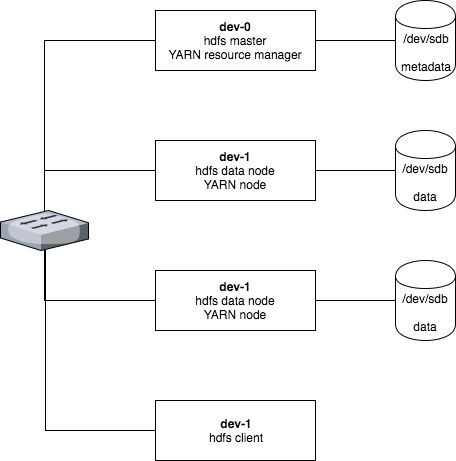Hadoop has become the defacto file system for I/O intensive big data applications. Hadoop differentiates itself from traditional distributed filesystems with its principle of data locality. Built into the filesystem is a job scheduler (by default, Yarn) that is able to execute jobs of a specific type (by default, MapReduce) directly on the storage cluster. It is even possible to define the topology of the cluster so that Yarn can execute work on nodes closest to the data on which they will operate. This allows these data processing jobs to operate at near native-device speeds.
Truth be told, however, Hadoop is actually a slow(er) filesystem… at least when compared to others like Lustre, GPFS, WekaIO, etc. If your workload does not easily fit MapReduce, or one of the other Hadoop compatible analytics engines, then maybe Hadoop is not for you. The following are the reasons to consider Hadoop:
- Data Locality when using HDFS Analytics Engines
- Lower Cost - Data drives do not require RAID in production
- Highly scalable
- Efficiently manages large amounts of unstrctured data
Simple Cluster Setup
We can get started with Hadoop by building a simple cluster.

This cluster will consist of three nodes and one client. Each node will have a single storage device which means one drive for metadata and two drives for data. The following steps will be followed to create the cluster.
- Create local hadoop system account for running the daemons.
- Distribute hadoop user SSH key from the master to the worker nodes.
- Install/configure Java and dependencies.
- Download, extract, and install the compiled release of Hadoop.
- Format Hadoop drives as ext3.
- Configure Hadoop:
- Set the correct Java runtime.
- core-site.xml - Defines master node
- hdfs-site.xml - Defines data directories and data replication.
- mapred-site.xml - Defines the MapReduce options and scheduler type.
- yarn-site.xml - Defines YARN configuration and resource manager.
- workers - List of all cluster worker nodes.
- Configure host firewalls.
Deployment with Ansible
Anything that is worth doing is worth being automated. I have automated this deployment with Ansible. The role, playbook, and example inventory file can be downloaded from GitHub.
To use this playbook, customize the values in the inventory file at hosts/hadoop. The current values match the diagram above. Be sure that all of the nodes in the Hadoop cluster can reach the internet. If they cannot, be sure to configure the proxy settings. Lastly, be sure to verify the settings in ansible.cfg. By default, Ansible will assume it can SSH to the node as the current user without a password and then sudo to root without a password.
Once everything has been configured to your site-specific settings, you can launch the playbook. From the repository root directory:
ansible-playbook -l hadoop playbooks/hadoop.yml
Once this has finished running, you should almost have a functional hadoop cluster. The Hadoop software has been installed to /opt/hadoop/hadoop-3.1.1. The binaries and configuration files are all in this directory structure. All that is left to do is format your HDFS file system and start the daemons.
To format the filesystem, from the master node, issue the following command:
hdfs namenode -format
To start the Hadoop daemons, become the hadoop user and issue the start commands.
sudo su - hadoop
/opt/hadoop/hadoop-3.1.1/sbin/start-dfs.sh
/opt/hadoop/hadoop-3.1.1/sbin/start-yarn.sh
To shutdown the HDFS filesystem, use the stop commands.
sudo su - hadoop
/opt/hadoop/hadoop-3.1.1/sbin/stop-dfs.sh
/opt/hadoop/hadoop-3.1.1/sbin/stop-yarn.sh
Debugging Issues
When running into issues, the problem is almost always an issue with memory allocation to the various JVM’s. Linode’s documentation [1] explains how to increase this with nice diagrams.
External Sources
- “How to Install and Set Up a 3-Node Hadoop Cluster.” Linode Guides & Tutorials, 16 Oct. 2017, www.linode.com/docs/databases/hadoop/how-to-install-and-set-up-hadoop-cluster/.
- “Install, Configure, and Run Spark on Top of a Hadoop YARN Cluster.” Linode Guides & Tutorials, 23 Oct. 2017, www.linode.com/docs/databases/hadoop/install-configure-run-spark-on-top-of-hadoop-yarn-cluster/.